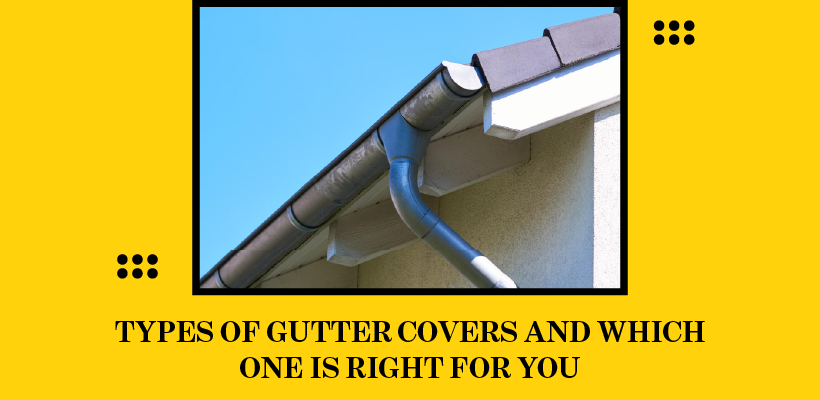Types of Gutter Covers and Which One Is Right for You
Are you confused which gutter cover is the best for your home’s gutter system? Let us help you understand the gutter cover types and how they work.
Ensuring that your gutters remain clean and functional is crucial for protecting your property from water damage. One of the most effective ways to maintain your gutters is by installing gutter guards.
These protective coverings are designed to prevent your gutters from clogging and overflowing, reducing maintenance time and enhancing their longevity. With so many gutter cover types available, understanding the advantages of each type and choosing the right one can feel overwhelming.
In this blog, we’ll discuss the most popular gutter cover types and how to determine which gutter cover works best for your home’s rain gutter.
Why Gutter Covers Are Important
Rain gutters are designed to channel water away from your roof and foundation, protecting your home from leaks, erosion, and structural damage. However, without protection, gutters can become clogged, leading to overflowing water, foundation issues, and costly repairs.
Gutter covers prevent debris from entering your gutters while still allowing water to flow freely. They minimize the need for frequent gutter cleaning and extend the lifespan of your gutter system.
Common Gutter Cover Types
There are several gutter cover types, each designed to meet different needs and budgets. Here’s a breakdown of the most common options:
- Screen Gutter Covers
Screen covers are made of metal or plastic mesh that sits over your gutters. They allow water to pass through while blocking leaves and larger debris.
Pros:
- Affordable and easy to install
- Lightweight and effective for homes with moderate debris
Cons:
- Small debris, like pine needles, can still enter
- Require occasional cleaning
- Micro-Mesh Gutter Covers
Micro-mesh covers feature tiny perforations that block even the smallest debris, including pine needles and shingle grit. They provide superior protection compared to standard screen covers.
Pros:
- Highly effective at preventing clogs
- Minimal maintenance required
Cons:
- More expensive than basic screens
- Professional installation recommended for best performance
- Reverse Curve Gutter Covers
Reverse curve or surface tension covers are designed to guide water into the gutter while debris slides off the edge. These covers are typically made of metal and provide a sleek appearance.
Pros:
- Excellent at keeping large debris out
- Durable and long-lasting
Cons:
- It can be more expensive
- Water overflow may occur in heavy rainfall if it is not installed correctly
- Bottle Brush Gutter Covers
Bottle brush covers consist of bristle-like material that fits inside the gutter, preventing debris from accumulating while letting water flow through.
Pros:
- Easy DIY installation
- Affordable and reusable
Cons:
- Bristles may trap small debris over time
- Less effective for heavy leaf fall or wet debris
- Foam Gutter Covers
Foam inserts fit directly inside your gutters and block debris while allowing water to seep through the porous material.
Pros:
- Simple to install without tools
- Works well for light debris areas
Cons:
- It can degrade over time due to sun exposure
- May require replacement more often than metal or mesh covers
How to Choose the Right Gutter Covers For Your Home
Choosing the best gutter cover type depends on several factors:
- Debris Load: If trees are present, a micro-mesh or reverse curve cover is ideal. For minimal debris, a screen or foam insert may suffice.
- Budget: Basic screens and bottle brush covers are cost-effective, while micro-mesh and reverse curve options are more expensive but offer superior protection.
- Maintenance Preference: If you want to minimize maintenance, invest in high-quality micro-mesh or reverse curve gutter covers.
- Roof and Gutter Type: Some gutter cover designs are better suited for specific rain gutters, so check compatibility before purchasing.
Benefits of Installing Gutter Covers
Installing gutter covers offers several advantages for homeowners:
- Reduced Gutter Cleaning: Debris is kept out, reducing the frequency of gutter maintenance.
- Prevents Water Damage: Proper water flow prevents leaks, foundation issues, and basement flooding.
- Prolongs Gutter Lifespan: Keeping gutters clear reduces corrosion and wear.
- Pest Deterrent: Blocks birds, rodents, and insects from nesting in gutters.
The Bottom Line
Understanding the various types of gutter guards and their advantages is the key to protecting your home’s rain gutter from clogging and water damage. Choosing the right cover depends on the environment of your home, the load of debris, and maintenance.
If your gutters are clogged and require proper cleaning and repairing, consider hiring a professional for effective cleaning and maintenance.
Sunshine Gutters South is a full-service gutter cleaning and maintenance service provider in Monte Sereno, Los Gatos, San Francisco, and Milpitas. Get in touch to learn more about various gutter cover types.
FAQ’s
What are the most common gutter cover types?
Screen guards, micro-mesh guards, reverse curve guards, bottle brush guards, and foam inserts are the most popular types.
Which gutter cover type is best for homes with lots of trees?
Micro-mesh and reverse curve guards are ideal for areas with heavy leaf fall because they block small and large debris effectively.
Are gutter covers maintenance-free?
No, while they reduce cleaning, occasional inspection and cleaning are still necessary to remove fine debris.
Can gutter covers prevent water damage?
Yes, by keeping gutters clear, they ensure proper water flow, protecting your roof, walls, and foundation from water damage.

